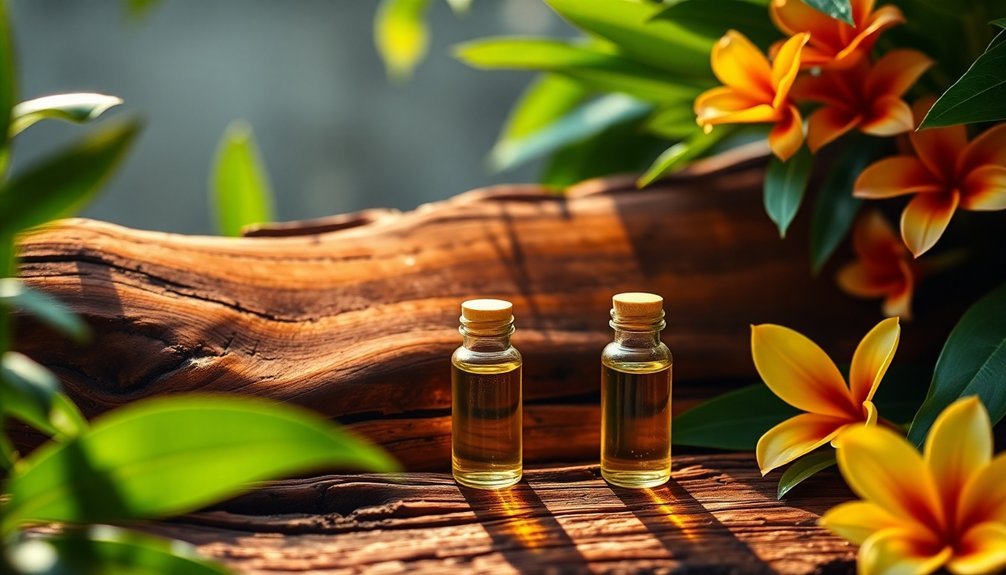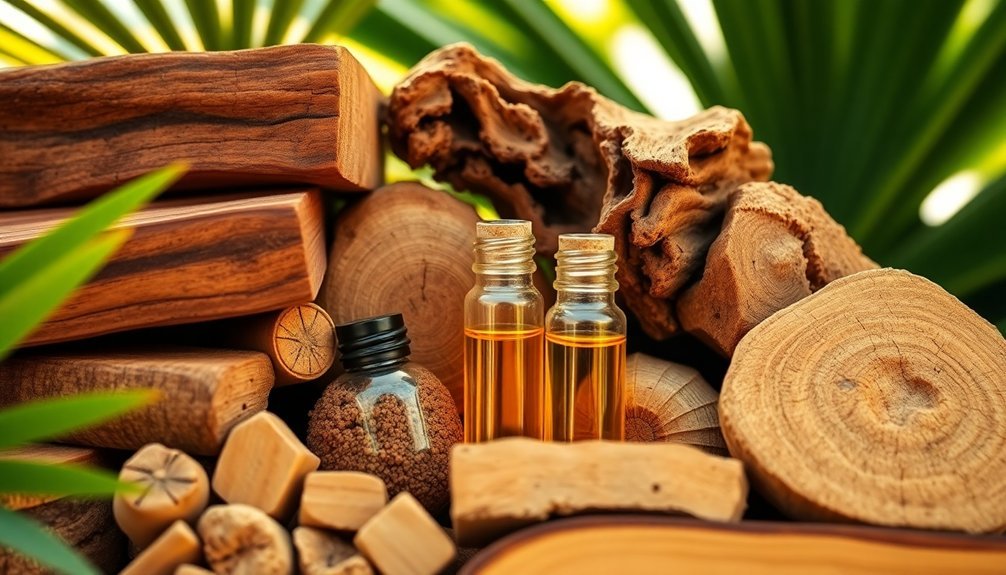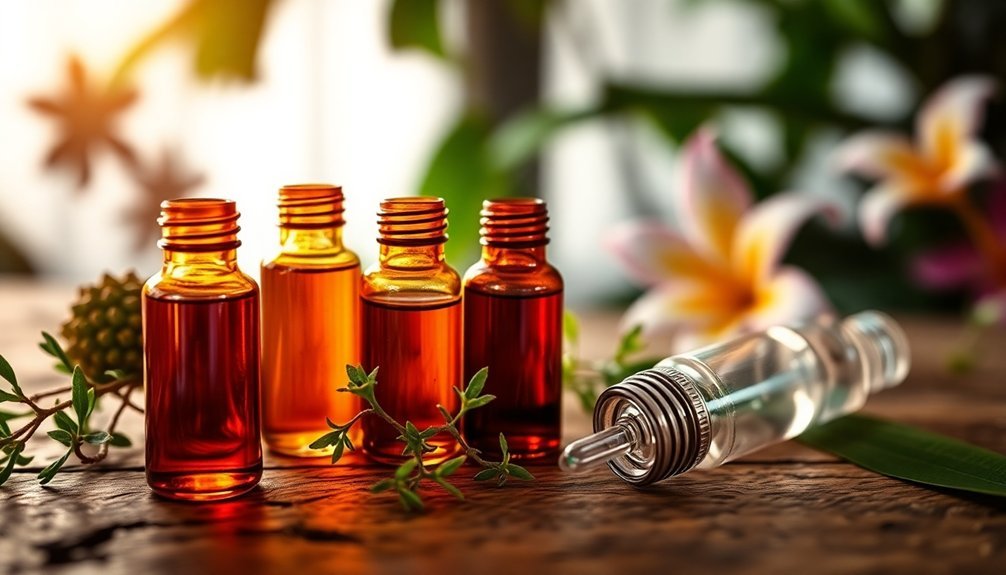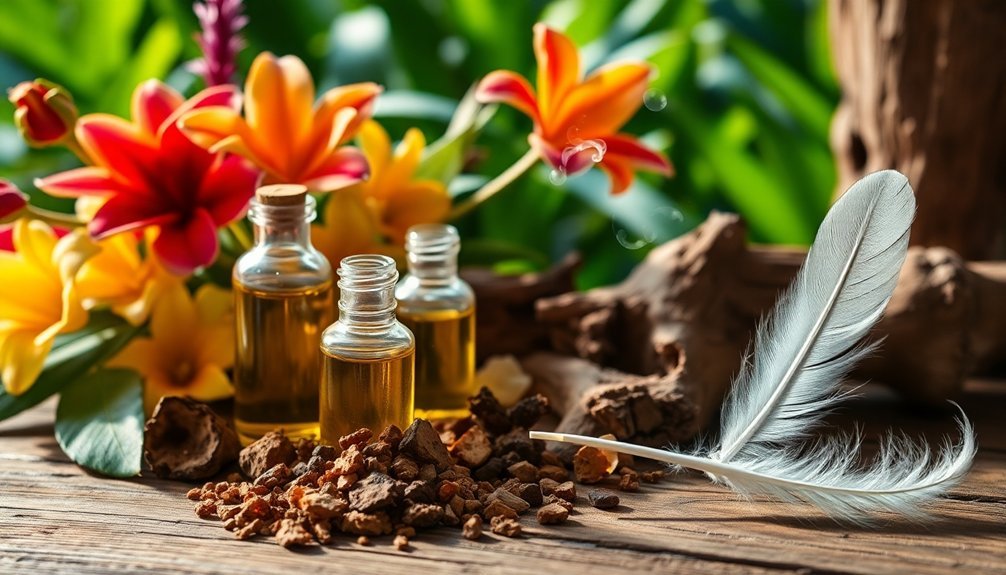To create sultry tropical wood perfumes, start with premium oud or sandalwood as your base, verifying their authentic resin content. You'll want to layer compatible woods like cedarwood and vetiver, then balance them with sweet amber and exotic florals like frangipani. Add depth through spices like cinnamon and ginger, while incorporating bright fruit notes such as coconut and citrus. Use natural fixatives for longevity, and follow the 30:50:20 ratio formula. These techniques are just the beginning of your journey into luxurious tropical perfumery.
Selecting Premium Tropical Woods for Your Base Notes

When crafting tropical wood perfumes, selecting the right base notes forms the foundation of your fragrance. Start with high-quality agarwood (oud), which should display a dark, rich color and intense woody aroma. Adding Malaysian Aoud wood ensures an authentic richness to your blend, as this variety is particularly coveted for its depth.
You'll want to verify your oud has a strong, lingering scent that indicates high resin content, as this proves its authenticity and quality.
When sourcing your tropical woods, prioritize sustainable and ethically harvested materials. Since authentic oud is rare and expensive, confirm your supplier's reputation and sourcing practices.
Pay attention to the wood's natural depth and complexity – premium oud will exhibit layered notes that evolve on the skin.
Balancing Sweet and Spicy Elements With Woods
Building on your foundation of premium tropical woods, the art of balancing sweet and spicy elements will transform your perfume from a single-note fragrance into a complex masterpiece. You'll want to layer amber and vanilla notes to add warmth and sophistication, while incorporating spices like cinnamon and ginger to create depth and intrigue. Understanding the relationships shown in the fragrance wheel placement will help you create harmonious combinations between these elements.
| Sweet Elements | Spicy Elements |
|---|---|
| Amber | Ginger |
| Vanilla | Cinnamon |
| Benzoin | Frankincense |
| Jasmine | Leather |
| Honey | Myrrh |
For the most harmonious blend, start with subtle amounts of your sweet and spicy elements, gradually building up the intensity until you achieve the perfect balance. Don't forget to complement your woods with floral notes like jasmine to add brightness, while smoky and leathery accords will enhance the exotic, sultry character of your tropical wood perfume.
Creating Depth Through Layered Wood Accords

You'll achieve greater complexity in your tropical wood perfumes by thoughtfully pairing compatible wood notes, such as combining sandalwood with vanilla or cedarwood with patchouli.
To create a dynamic fragrance profile, try layering darker, heavier woods with lighter, airier ones – like rosewood with citrusy notes. The floriental wood accord provides an excellent foundation for creating sophisticated tropical fragrances.
Start with the strongest wood accord as your foundation, then build layers using complementary scents that share similar fragrance families or harmonious notes.
Pairing Compatible Wood Notes
Creating depth in tropical wood perfumes requires strategic pairing of compatible wood notes.
You'll want to start with sandalwood as your foundation, then enhance it with cedarwood to create a richer, more complex base.
Add vetiver to introduce earthy undertones that complement the creamy warmth of sandalwood.
For a sultry tropical twist, you can layer Sandalore® with patchouli, which adds sensuality and dark character to your blend.
Oak wood's subtle smokiness works particularly well when you're aiming for depth without overwhelming the composition.
To maintain balance, pair these woods with Polysantol® in the heart notes.
You'll find that these combinations create a sophisticated tropical wood perfume that's both rich and nuanced, offering a perfect foundation for additional tropical accents.
Blending Dark With Light
While depth emerges naturally from dark woods like ebony, achieving a balanced tropical fragrance requires careful layering with lighter accords.
You'll want to pair ebony's rich smokiness with lighter floral notes like jasmine or rose to create an elegant contrast. This interplay between dark and light adds sophistication to your blend.
To enhance complexity, combine ebony with other woody notes strategically.
Try adding cedarwood for warmth or sandalwood for creamy richness. You can also incorporate vetiver or patchouli to build earthiness while maintaining balance.
When working with florals, consider how they'll interact with your wood base – jasmine's sweetness can beautifully offset ebony's darkness.
Don't hesitate to mix natural and synthetic accords.
This approach lets you fine-tune the intensity and achieve consistent results in your tropical wood compositions.
Mastering the Art of Tropical Fruit-Wood Fusion
The artistry of tropical fruit-wood fusion represents a delicate balance between vibrant, exotic fruits and rich, earthy woods. You'll discover that fruits like peach, plum, and nectarine add luxurious texture, while citrus notes create invigorating top notes. When you're blending, pair sandalwood's creamy aroma with coconut and pineapple, or combine cedarwood with bright citrus elements.
| Wood Note | Fruit Pairing | Effect |
|---|---|---|
| Sandalwood | Coconut/Pineapple | Creamy, sensual |
| Cedarwood | Citrus/Bergamot | Fresh, lasting |
| Vetiver | Guava/Mandarin | Earthy, bright |
| Patchouli | Peach/Plum | Complex, musky |
| Oud | Nectarine/Lemon | Rich, honeyed |
To achieve depth, layer your creation with spices like ginger and clove, then anchor it with a balanced base of amber and musk. This combination guarantees your fragrance remains sophisticated while maintaining its tropical allure.
Essential Oil Ratios for Long-Lasting Woody Scents

Now that you've mastered fruit-wood combinations, precise oil ratios become your next focus for crafting enduring tropical wood perfumes.
Start with the proven 30:50:20 formula – using 3 drops of top notes, 5 drops of middle notes, and 2 drops of base notes in a 10-drop blend.
For tropical wood scents that last, increase your base note proportion using oils like Cedarwood, Sandalwood, or Frankincense.
You'll want to balance stronger scents with lighter ones to avoid overwhelming the blend. Test your combinations on perfume strips, and don't rush to finalize your formula.
Let your blend rest for 48 hours in a dark bottle to allow the oils to harmonize.
Always dilute your final blend in a carrier oil at a 5% ratio to guarantee both safety and longevity.
Enhancing Wood Notes With Exotic Florals
You'll find that jasmine's rich, sensual character can dramatically intensify oud's mysterious depth when blended in the right proportions.
Combining rose and frangipani creates an exotic alliance that brings out the best qualities of both florals while complementing woody base notes.
These floral fusion techniques allow you to craft complex tropical wood perfumes that maintain their integrity throughout the day.
Jasmine Amplifies Oud Depth
While many perfumers focus solely on oud's intense character, adding jasmine creates an unexpectedly harmonious blend that elevates both ingredients to new heights.
You'll find that jasmine's lush floral sweetness perfectly balances oud's smoky intensity, resulting in a sophisticated and mysterious fragrance.
To achieve this balance, start with a 3:1 ratio of oud to jasmine absolute.
You can further enhance the blend by incorporating complementary woods like sandalwood for opulence or cedarwood for earthy contrast.
Consider adding cardamom or black pepper in the top notes for an invigorating opening, while osmanthus or ylang-ylang in the heart will soften the floral aspects.
For a lasting base, layer soft musk and tonka bean beneath the oud-jasmine accord.
This combination creates a sensual fragrance that's both refined and complex.
Rose-Frangipani Fusion Techniques
Creating an enchanting fusion of rose and frangipani requires careful consideration of balance and proportion to enhance woody base notes.
You'll want to start by blending frangipani's distinct tropical aroma with rose's floral heart, ensuring neither overpowers the other. This combination creates a sultry foundation that pairs beautifully with woody elements.
To achieve depth and sophistication, layer your floral fusion with cedarwood or vetiver for a crisp finish, or choose sandalwood for warmth.
You can heighten the tropical aspect by adding bergamot as a top note, which brings freshness to the blend. Remember to experiment with different ratios until you find the perfect balance.
The key is creating a multi-dimensional fragrance where the rose-frangipani duo complements rather than competes with the wood notes.
Achieving the Perfect Sillage With Natural Fixatives

To achieve the perfect sillage in tropical wood perfumes, natural fixatives play an essential role in stabilizing and extending your fragrance's life.
You'll want to focus on powerful fixatives like patchouli dark, vetiver, and buddha wood, which effectively bind to volatile molecules and slow their evaporation.
Layer your fixatives strategically by combining different types. For instance, blend patchouli with vetiver to create a stable base that allows your tropical wood notes to unfold gradually.
When working with strong fixatives like absolutes or CO2 extracts, remember to dilute them properly in perfumer's alcohol to avoid overpowering your composition.
Consider environmental factors and seasonal variations when selecting your fixatives.
You can enhance longevity by balancing top, middle, and base notes while maintaining the authentic character of your tropical wood perfume.
Frequently Asked Questions
How Do Tropical Wood Perfumes Perform in High Humidity Environments?
You'll find tropical wood perfumes perform exceptionally well in high humidity, as they maintain their freshness and lasting power. When combined with clean musk notes, they'll provide a long-lasting, invigorating fragrance experience.
Can Synthetic Wood Notes Effectively Replace Rare Tropical Woods?
You can't fully replace rare tropical woods with synthetics alone. While they offer consistency and sustainability, you'll miss the complex, authentic profiles. It's better to use synthetics to enhance natural woods instead.
What Equipment Is Essential for Making Tropical Wood Perfumes at Home?
You'll need measuring cylinders, glass beakers, pipettes for precise oil drops, blotter strips for testing scents, roll-on bottles for storage, and notebooks to record recipes. Don't forget protective equipment like gloves.
How Long Should Tropical Wood Perfumes Macerate Before First Use?
You'll need to macerate your tropical wood perfumes for at least 4-6 weeks, but for best results, let them rest for 3-4 months. This allows the woody notes to fully blend and develop depth.
Are Tropical Wood Perfumes Suitable for Sensitive Skin Types?
While tropical wood perfumes are often hypoallergenic, you'll still need to do a patch test first. They're generally suitable for sensitive skin, but individual reactions vary. Consult a dermatologist if you're particularly sensitive.
In Summary
You've now mastered the key elements of crafting tropical wood perfumes that captivate and endure. By carefully selecting your base notes, balancing your accords, and understanding the interplay between woods, fruits, and florals, you'll create scents that transport wearers to exotic destinations. Remember to trust your nose and don't be afraid to experiment – your unique creative vision will help you develop truly memorable fragrances.





Leave a Reply